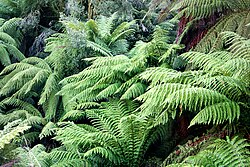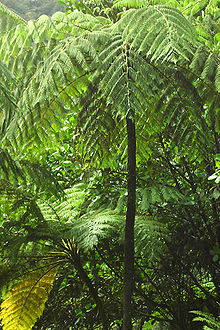Our website is made possible by displaying online advertisements to our visitors.
Please consider supporting us by disabling your ad blocker.
Tree fern
| Tree fern (Cyatheales) | |
|---|---|

| |
| Dicksonia antarctica | |
| Scientific classification | |
| Kingdom: | |
| Division: | |
| Class: | Polypodiopsida/Pteridopsida
|
| Order: | Cyatheales
|


Tree ferns are a large group of ferns with tree-like form. They are part of a subclass of ferns which is monophyletic by DNA sequence analysis.[1]
The tree-ferns and some other ferns with creeping rhizome stems make up the Cyatheales group of ferns (as a sub-class or order). The tree-like habit has evolved a number of times in this group.[2] They can grow up to 20 metres tall, with their large fronds at the top.[3] Many are much shorter, however.
The coal forests of the Lower Jurassic were mainly formed by tree ferns and cycads. Tree ferns were probably food for Ankylosaurs in the Upper Jurassic, as were cycads.
Tree ferns are found growing in tropical and subtropical areas as well as temperate rainforests in Australia, New Zealand, and other island groups nearby. A few genera extend further, such as Culcita in southern Europe. Like all ferns, tree ferns reproduce by means of spores developed in sporangia on the undersides of the fronds. The fronds of tree ferns are usually very large, and multiple-divided fronds. The young fronds of ferns emerge in coils that uncurl as they grow.
Unlike flowering plants, tree ferns do not form new woody tissue in their trunk as they grow. Rather, the trunk is supported by a fibrous mass of roots that expands as the tree fern grows.
It is not certain how many species of tree fern there are but it is likely to be around a thousand. New species are discovered in New Guinea with each botanical survey. Many species must have become extinct in the last century as forest habitats were cut down.
- ↑ Korall P. et al 2006. Tree ferns: monophyletic groups and their relationships as revealed by four protein-coding plastid loci. Molecular Phylogenetics and Evolution 39: 830-845.
- ↑ Judd W.S. et al (eds) 2008. Plant systematics: a phylogenetic approach. 3rd ed, Sinauer Associates, Sunderland, Massachusetts.
- ↑ Large M.F. & Braggins J.E. 2004. Tree ferns. Timber Press. ISBN 0-88192-630-2
Previous Page Next Page


